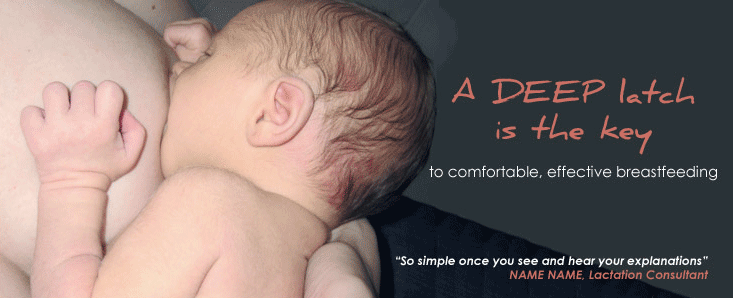
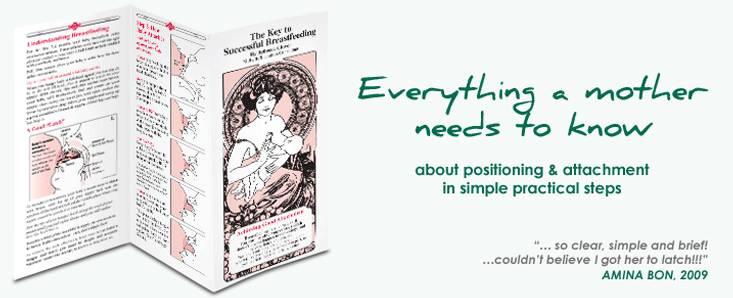
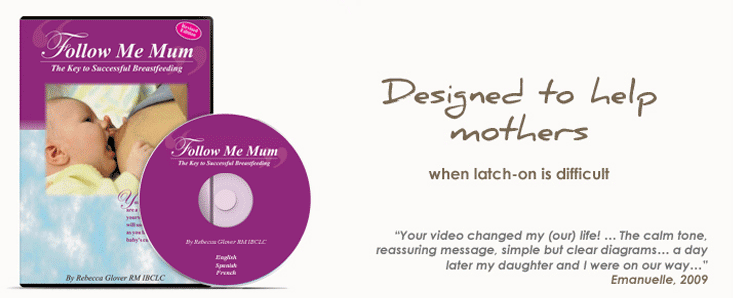
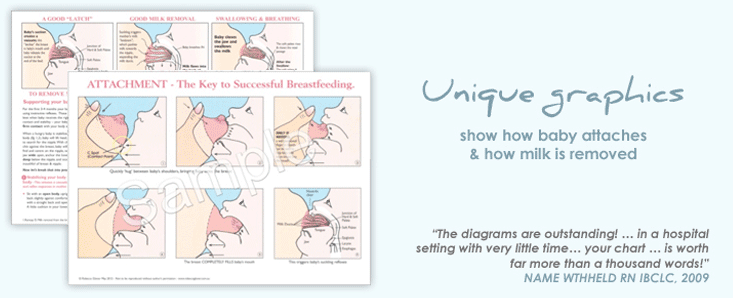
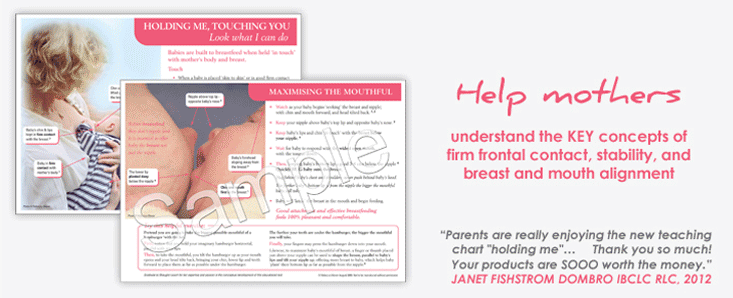
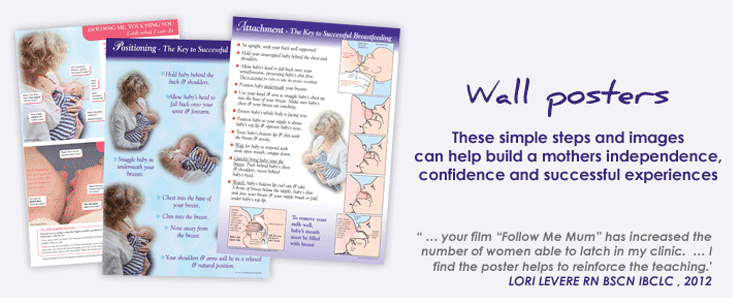
Can you help me Breastfeed?
Building Breastfeeding Self-efficacy – from theory to practice
Click on a Heading to go directly to that section of the article
Introduction – Should we teach mothers about breastfeeding?
Clinical Applications of Self-efficacy Theory – a modifiable variable
How Self-Efficacy Belief is Attained – a modifiable variable
Repeated Successful Experiences - Performance Accomplishment or Task mastery
Modeling successful behaviours - Vicarious Experience
Relevant additional information & Positive practical coaching
Attend to the mothers Physical and Emotional Comfort
Building Self-efficacy in Clinical Practice via Participatory Modelling
Keep your #1 modelling buddy close
Introduction – Should we teach mothers about breastfeeding?
Recent evidence about innate infant latching behaviours has caused us to question the way we approach ‘helping’ mothers learn to breastfeed. To ask; do postpartum mothers also have hard wired instinctive breastfeeding behaviours, or is our brain hard wired to learn from our surroundings.
Scientific evidence from fields such as anthropology and neuroscience show that it is likely to be some of both and I believe that we need to recongnize that they are both part of a mothers learning experience.
1. Because breastfeeding is a basic survival behaviour it seems probable that, like their babies, mothers will have some hardwired instinctive breastfeeding behaviours.
2. Based on recent discoveries about the plasticity of the human brain and how it interacts with its environment, mothers come to breastfeeding with a brain that is always open and learning from a variety of sources in a variety of ways.
The question I ask is how do we best support both of these aspects for the mother who is learning to breastfeed? This would enable us to move confidently along, or back and forth on a helping continuum, choosing the best approach for each individual situation.
Ensuring that we support and protect the instinctive interaction between a mother and her baby, at the same time knowing how to impart additional relevant imformation in a way that supports and protects her confidence in her ability to breastfeed. (see Helping Continuum Table - Free Downloads)
Even with Baby led or Biological Nurturing approaches mothers are given some guidance or instruction and if baby is not able to attach, further information and assistance are needed.
When a baby is unable to latch and a mother needs additional help, what and how should we teach her? Do we run the risk of introducing unproven or unhelpful interventions? Absolutely yes, we need to be very careful what we do, and even more careful what we say.
What? - Model, describe and explain about her baby's inborn latching reflexes and how to support them - good place to start
How? - There is help for the helper, that is evidence based, practical and easy to impliment. A way that has been shown to help us become competent and confident performing any new skill or behavior.
Clinical Applications of Self-efficacy Theory – a modifiable variable
Many known predictors of breastfeeding success or failure are NON-modifiable social or demographic variables, such as maternal age, education level, socioeconomic status or support from significant others; things that we cannot change during the short relationship we have with a breastfeeding dyad.
However, there is a way to improve success rates in the early post partum period. More than 30yrs of studies in practical settings across fields as diverse as athletics, health, business and education have shown that a person’s sense of Self- Efficacy – belief in their ability to accomplish a task or deal with the challenges of life - is a strong predictor of the outcome, the higher the self-efficacy the higher the likelihood of success. Stajkovic, A. D., & Luthans, F. (1998)
Recent studies have identified that “Enhanced maternal self-efficacy is a modifiable variable associated with successful breastfeeding outcomes” Kingston (2007) Noel-Weiss J, Bassett V, Cragg B. (2006)
In their Study “The Relationship between Vulnerability Factors and Breastfeeding outcome” Dunn (2006) looked at the “The relationship between the vulnerability factors [breastfeeding confidence, PND, supplementation, perceived adequacy of support] & breastfeeding outcome at 6 wks post partum.” After controlling for age and education, they found that “Maternal confidence was the strongest predictor of breastfeeding outcome” (odds ratio: 1.85, 95% CI : 1.50-2.27, P
These findings are consistent with previous research by: Dennis 1999; Blyth et al., 2002; Buxton et al., 1991; O’Campo et al.,1992; Painzak & Turner, 2000; Creedy 2003.
How Self-Efficacy Belief is Attained – a modifiable variable
First published in 1977, Bandura’s theory of Self Efficacy describes 4 principle sources of information that build self-efficacy belief and give us a proven framework on which to base our interactions with the breastfeeding mother. The sources of information are:
- Performance Accomplishment or Task Mastery which involves learning through successful experiences
- Vicarious experience – Learning by seeing others successfully perform the task, directly (several models better than one) or via a variety of tools and visual aids
- Verbal persuasion - information from a credible source that facilitates effective performance
- Emotional/Physiological state affects how an individual perceives their ability to perform a task, negative emotions of fear, anger, hopelessness will lower self efficacy
The most powerful source of self belief comes from repeated successful experience, followed by seeing others successfully perform the task, then additional practical relevant information about the task from a credible source in an emotionally safe and physically comfortable environment.
Repeated Successful Experiences - Performance Accomplishment or Task mastery
Every successful experience a mother has builds her belief in her ability to breastfeed and lays down neural connections in her brain. Bandura showed that, “strong efficacy is developed through repeated success”, 1977 p195. and recent neuroscience has shown that repeated performance of a task creates stronger more lasting pathways in the brain.
The emphasis on personal mastery experiences has important clinical implications, indicating where we should focus our efforts. Initially by “Supporting birth practices that minimize birth interventions and mother-baby separation; facilitating extended post birth skin-to-skin contact; and encouraging a biological nurturing approach …. Can all help convince a mother of her own and her baby’s competence and ability to succeed.” (Glover R. Wiessinger D. 2012) Then, if baby is unable to attach, we can help most by maintaining our focus on personal mastery experiences. Because “successful experiences increase self-efficacy, [and] repeated failures diminish it”, (Dennis 1999 p 196).
Even before a comfortable latch is achieved education strategies and information that “lead to or enable a series of smaller successes can strengthen a mothers self-efficacy so she remains eager to reach her breastfeeding goals. Imagine the pleasure the mother of a non-latching baby can derive simply from knowing how to make herself and her baby fit comfortably together.” (Glover R. Wiessinger D. 2012)
Modeling successful behaviours - Vicarious Experience
Modelling successful behaviours can quickly lead to successes as it helps mothers know what to do without undergoing a trial and error process, preventing them from repeating errors that will diminish self-efficacy. Be aware that unless modern mothers are modelled successful breastfeeding behaviours they will be using the models they have observed in our predominantly non-breastfeeding culture. e.g. cradling baby in the crook of the arm – pointing and putting the nipple into baby’s mouth.
Self-efficacy studies have shown that “the effects of modelling are particularly relevant when people are uncertain of their abilities or when they have limited prior experience”. Pajares (2002). Furthermore, repeated modelling of clearly successful outcomes, by a variety of models, and demonstrations that simplify a complex behavior by breaking it into easy steps, have all been shown to enhance self-efficacy effects. Bandura (1977)
The use of different forms of visual media such as video, pictures, graphics and modeling demonstrations with a doll can provide mothers with the varied vicarious learning experiences they need. Total success is not always immediately but, if we have the appropriate knowledge and skills, successes can be achieved one step at a time. Pajares (2002) warns that “It is important to know the precise nature of the skills required to successfully perform a particular behavior”. See 7 Fundamental latching behaviours – Helping continuum table Free Downloads or Be Clear-Be Concise-Be a Coach
Relevant additional information & Positive practical coaching
Verbal persuasion (information) is only helpful to the extent that it is relevant to the task, comes from a helper the mother perceives as credible and clearly contributes to the mothers ability to succeed. It includes; clear simple descriptions of what is being modeled, the reasons why the step is important, encouragement in the form of positive and practical coaching as the mother is learning a skill - encouraging helpful actions and preventing errors that will lead to failure and diminish the mothers self-efficacy.
Bandura warns that it is easier to verbally undermine than to build self-efficacy. Advising that “To raise by persuasion expectations of personal competence, without arranging conditions to facilitate effective performance , will most likely lead to failures that discredit the persuaders and further undermine the recipients perceived self-efficacy” Bandura 1977 p 197. 25 years on Pajares added that “Effective persuaders must cultivate people’s beliefs in their capabilities while at the same time ensuring that the envisioned success is attainable”.
The helper who tries to be positive by saying “you’re doing a great job, or baby looks well attached” will not build self-efficacy in a mother who is breastfeeding in pain.
Verbal information can be a valuable tool for us but should be “kept to a minimum, simply stated, rich in analogies, playfulness and demonstrations.” (Glover, Weissinger 2012)
Attend to the mothers Physical and Emotional Comfort
Negative emotions such as pain, stress, fatigue, anxiety, fear, embarrassment, shame or hopelessness can lower self-efficacy belief and effect the ability to successfully perform a task. An experience that damages a mothers self-belief can become a self perpetuating cycle. For the mother who is experiencing breastfeeding difficulties there is a realistic basis for her fears. She needs to be shown new ways of behaving and helped to experience the healing balm of success.
Building Self-efficacy in Clinical Practice via Participatory Modelling
When a mother needs to help attach her baby, we can help most by using a coaching technique called Participatory Modeling, that combines all the sources of information to build self-efficacy in a breastfeeding mother.
Self-efficacy studies have shown that breaking a complex behaviour into small steps is helpful. Participatory modeling begins with a helper demonstrating the relevant step or steps of the innate latching behaviour with a doll, or video footage of mothers successfully performing the behaviour, or other relevant images, (vicarious experience) combined with clear description of what is being modelled and why it is important. (verbal persuasion)
The mother then replicates the modelled behaviour with her own baby, while the helper observes and assists her efforts. Giving her encouraging feedback on successful actions and preventing actions that will lead to failure.
So that, by the end of the session, both mother and helper are confident that the mother has understood, AND most important, experienced what she needs to do to succeed.
”Even before breastfeeding itself is successful, participatory modelling that leads to or enables a series of smaller successes can strengthen a mother’s self-efficacy so that she remains eager to reach her breastfeeding goals. Imagine the pleasure the mother of a non-latching baby can derive simply from discovering how to make herself and her baby fit together comfortably.” (Glover, Weissinger 2012)
Demonstration, replication, and repeated small successes are a powerfully effective route to success.
Keep your #1 modelling buddy close
Unless you always have at hand a group of successfully breastfeeding mothers, or the specific appropriate piece of video footage you may find a floppy newborn size doll to be your most helpful modelling tool.
“Too often, the breastfeeding helper tries to use verbal persuasion techniques alone. “You need to close the gap between you and your baby.” (“Close the gap?” the tired, frustrated new mother thinks. “I don’t even know what that means!”)
But the helper with a doll in tow can demonstrate, step by step, how to ensure that the baby is closely applied to the mother’s body, explaining what she is doing and why it is important. A helper with a doll represents a highly effective form of vicarious experience combined with verbal persuasion.” (Glover, Weissinger 2012)
Inappropriate verbal persuasion that is out of synch with the mothers experience is perhaps our least effective way to help!
Appropriate verbal persuasion when used in conjunction with Participatory Modelling can be one of our best.


